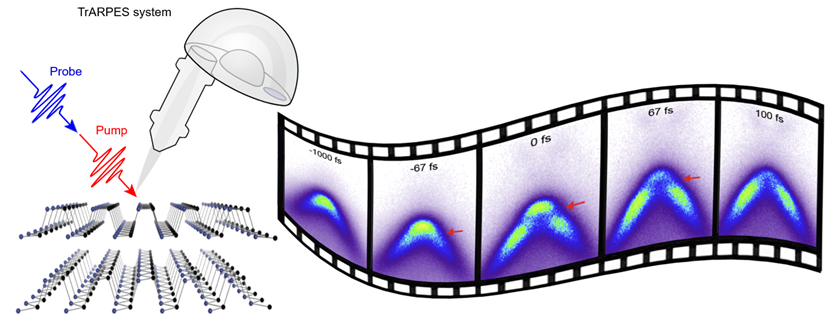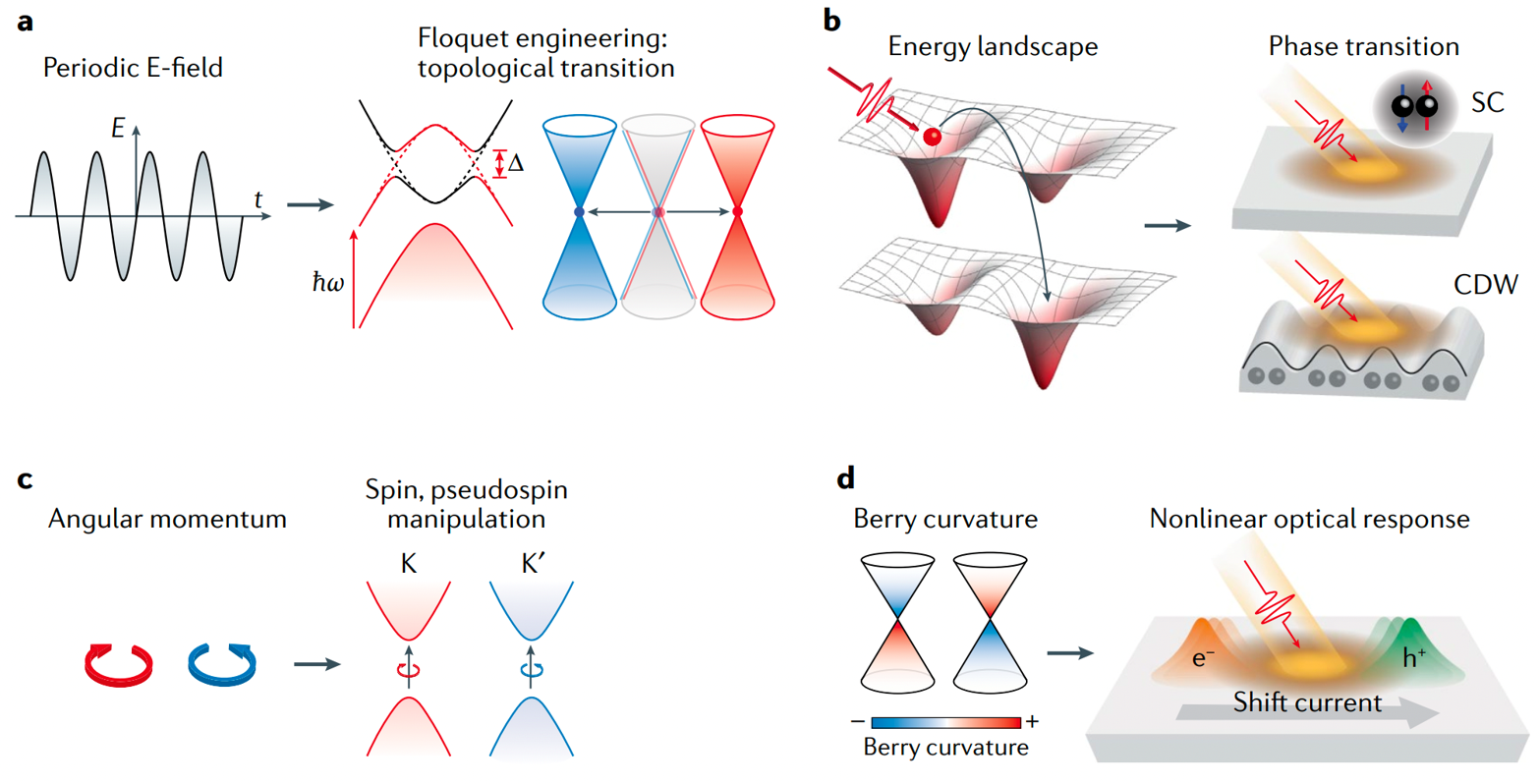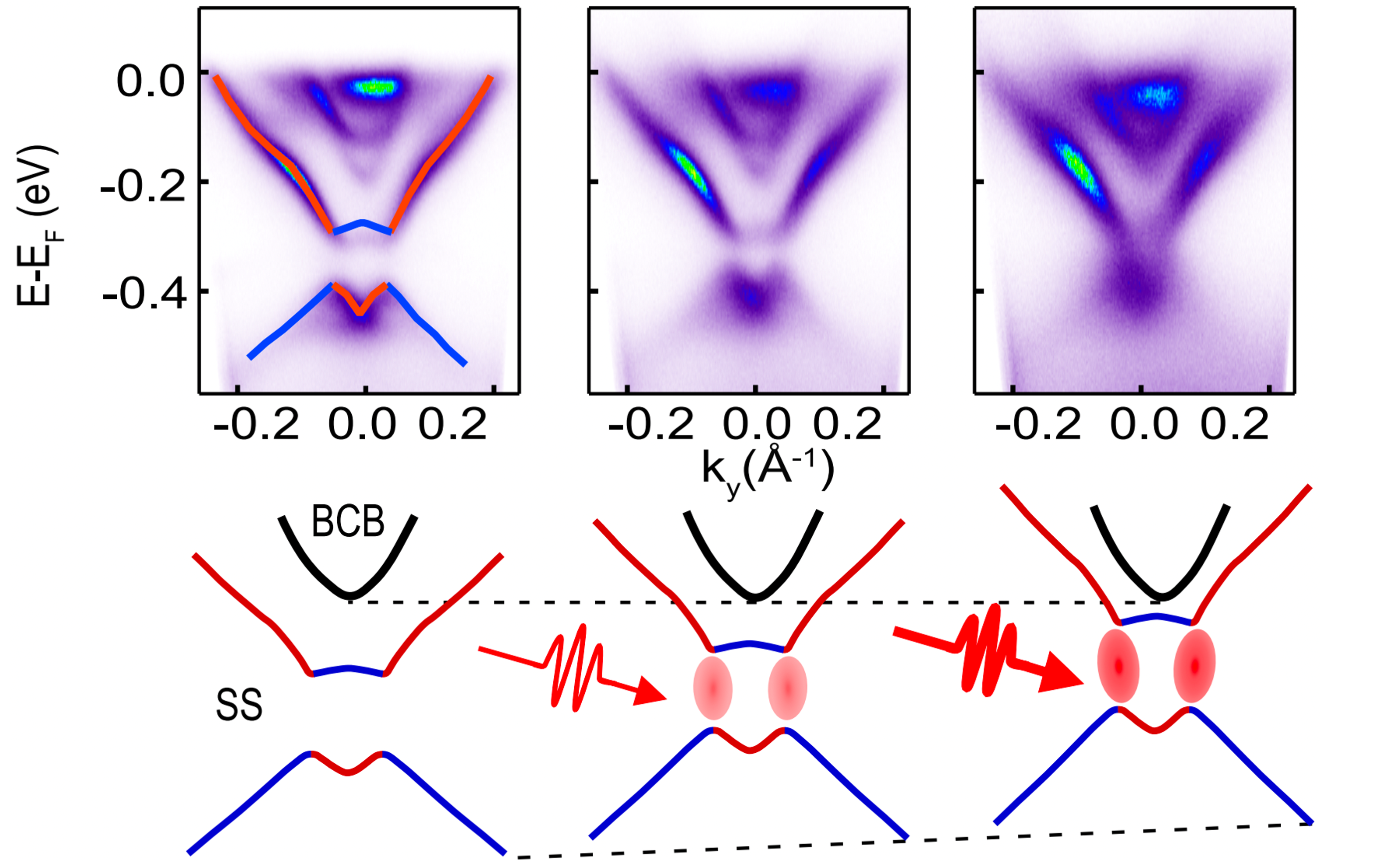Research / Ultrafast dynamics
>> Pseudospin-selective Floquet band engineering in black phosphorus
>> Light-induced emerging phenomena in two-dimensional materials and topological materials (overview and perspectives)
>> Population Inversion and Dirac Fermion Cooling in 3D Dirac Semimetal Cd3As2
>> Light-tunable hybridization gap and interlayer interaction in MnBi8Te13
>> Phonon threshold effect in the ultrafast relaxation dynamics of a Kekulé-order graphene
>> Pseudospin-selective Floquet band engineering in black phosphorus [Back To Top]

Time-periodic light field has emerged as a control knob for manipulating quantum states through Floquet engineering. Despite extensive research interests over the past decade, its direct observation is extremely limited. Recently, we have successfully reported the first experimental evidence of Floquet engineering in a semiconductor, black phosphorus, which shows dynamical light-induced gap upon mid-infrared pumping when the photon energy is tuned near resonance with the band gap. More interestingly, the dynamical gap can be controlled by changing the light polarization, suggesting pseudospin selectivity. This work not only provides important guiding principles for Floquet engineering of semiconductors, but also paves an important step toward light-induced emerging phenomena e.g., transient topological phase transitions. For more details, see Nature 614, 75–80 (2023)
[To Overview]
>> Light-induced emerging phenomena in two-dimensional materials and topological materials (overview and perspectives) [Back To Top]

The past decade has witnessed rapid progress in our understanding of quantum materials, particularly in the fields of quasi-2D materials and topological materials, thanks to advanced sample preparation techniques, more systematic understanding of topological physics and the development of various advanced, ultrafast, time-resolved measurements. In the investigation of two-dimensional materials and topological materials, light–matter interaction plays critical roles not only as an experimental probe but also as a control knob for inducing emergent non-equilibrium properties that are otherwise not possible to be achieved in the equilibrium state. Light-matter interaction can lead to rich phenomena, e.g. Floquet states, phase transition, spin and pseudospin manipulation and nonlinear optical response (see our recent review in Nature Reviews Physics (2022).). While major progress has been achieved in light-induced phenomena, so far, this field is still at a rapidly developing stage, with many predicted phenomena awaiting experimental realization. A deep understanding of light-induced phenomena is not only important for revealing the fundamental physics but is also useful for device applications, since many quantum devices are based on the interaction with light. Moreover, achieving dynamic tuning of the material properties in the picosecond (ps) to femtosecond (fs) timescale is critical for device applications operating at an ultrahigh speed.
In our group, we develop and apply ultrafast time-resolved ARPES (TrARPES) and apply it to reveal the intriguing light-induced phenomena in two-dimensional materials and topological materials.
[To Overview]
>> Population Inversion and Dirac Fermion Cooling in 3D Dirac Semimetal Cd3As2 [Back To Top]

Revealing the ultrafast dynamics of three-dimensional (3D) Dirac fermions is critical for both fundamental science and device applications. However, the lack of widely tunable probe photon energy in time- and angle-resolved photoemission spectroscopy (TrARPES) has hindered this research. By utilizing the newly developed TrARPES system with unique tunable probe photon energy, we successfully reveal the ultrafast dynamics of a model 3D Dirac semimetal Cd3As2 for the first time. A long-lived population inversion is discovered, thus highlighting the importance of the dimensionality effect in the ultrafast dynamics of Dirac fermions. For more details, see Nano Lett. 22, 1138-1144 (2022)
[To Overview]
>> Light-tunable hybridization gap and interlayer interaction in MnBi8Te13 [Back To Top]

MnBi8Te13 is an intrinsic ferromagnetic (FM) topological insulator with different complex surface terminations. Resolving the electronic structures of different termination surfaces and manipulation of the electronic state are important. Here, by using micrometer spot time- and angle-resolved photoemission spectroscopy (μ-TrARPES), we resolve the electronic structures and reveal the ultrafast dynamics upon photoexcitation. Photoinduced filling of the surface state hybridization gap is observed for the Bi2Te3 quintuple layer directly above MnBi2Te4 accompanied by a nontrivial shift of the surface state, suggesting light-tunable interlayer interaction. Our work reveals photoexcitation as a potential control knob for tailoring the interlayer interaction and surface state of MnBi8Te13. For more details, see Nano Lett. 21, 14, 6080-6086 (2021)
[To Overview]
>> Phonon threshold effect in the ultrafast relaxation dynamics of a Kekulé-order graphene [Back To Top]


